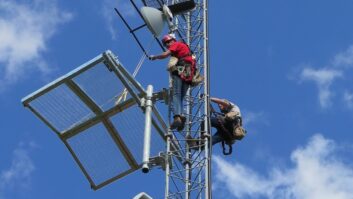Time and time again, in print and online, I have emphasized the need for safety while working around a transmitter and at transmitter sites. Of course, there�s nothing new about that. Safety has always been important for broadcast engineers and always will be.
�
My longtime colleague Larry Wood recently bought a framed set of NBC safety rules, as seen in the photo above, at an estate auction. It�s of interest because of the very �matter-of-fact� statement issued by the National Broadcasting Company back in the 1930s. I invite you to read the entire document.
�
The photo (above) might be a bit hard for some of you to read, so you can read the full text below.
�
Preface
�The members of the NBC Engineering Department shall at all times place personnel safety above all other considerations.� No reduction in outage time is worth the loss of a human life.� It is understood that, during interruptions to service, the personnel involved shall move to restore it as speedily as possible, but this must never be carried to the point where safety precautions are relaxed.� Those engaged in the operations of NBC technical facilities must strictly observe the following rules (as seen below), violations of which may result in demotion, suspension without pay or dismissal, depending upon the circumstances involved.�
DEFINITIONS OF DANGEROUS VOLTAGES�RADIO TRANSMITTER STATIONS
All voltages above 220 volts DC and 110 volts AC are to be considereddangerous voltages.�Allradio frequency circuits containing no DC and energized by tubes of 100 watts or more power are to be considered as carryingdangerous voltages.
RULES TO BE OBSERVED WHEN ASSOCIATING WITH DANGEROUS VOLTAGES
- POWER APPARATUS�supplying dangerous voltages to equipment upon which work is to be done shall be shut down.
- ALL CIRCUITS OF1000 VOLTS or more are to be satisfactorily grounded before being touched by the personnel. This may be effected with a knife switch, ground chain or ground wire.
- MECHANICAL AND ELECTRICAL INTERLOCKSwhich have been installed for safety purposes shall not be rendered inoperative.
- CONTROL VOLTAGESshall be removed from the control or interlock apparatus before any work is performed on it.
- FUSE TONGS shall be used when removing and replacing all fuses carrying dangerous voltages, and ASBESTOS GLOVES worn when handling hot vacuum tubes.
- DISCONNECT SWITCHES carrying 2200 volts or more shall be operated only with the use of a hook stick not less than 5 feet long for voltages up to 6600 and not less than 10 feet long for higher voltages.
- WARNING SIGNS shall be placed on control panels, disconnect switches or fuse clips when men are working on equipment away from them, as an indication that men are at work and that the equipment is not to be energized.� THESE SIGNS MUST BE PLACES ON THE PANELS BY THE MAN WHO IS TO DO THE WORK AND MAY BE REMOVED ONLY BY HIM.
- Only specially authorized persons are permitted to climb radio towers.� Until further notice all work of this kind is to be performed by competent riggers hired for the purpose.� This does not apply to the climbing of a tower to the winch platform in line of duty, but in no case is the height to be climbed to exceed 50 feet.�
I hope that you consider safety above all else when it comes to transmitter site work. The life you save may be your own.












